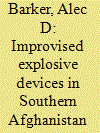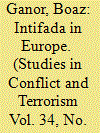|
|
|
Sort Order |
|
|
|
Items / Page
|
|
|
|
|
|
|
| Srl | Item |
| 1 |
ID:
106855


|
|
|
|
|
| Publication |
2011.
|
| Summary/Abstract |
This article considers in detail loyalist paramilitary activity in Northern Ireland since the paramilitary cease-fires of 1994. The continuing nature of contemporary loyalist violence is documented with reference to sectarian attacks against members of the "Other"/Catholic community and associated symbols of that community, violence directed at other loyalists, and the potential for future violence given constitutional uncertainty regarding Northern Ireland's position within the United Kingdom. The article also challenges assumptions within the broader literature of an inability within loyalist paramilitary groups to move beyond violence in the post-cease-fire period with particular reference to their conflict transformation efforts.
|
|
|
|
|
|
|
|
|
|
|
|
|
|
|
|
| 2 |
ID:
106852


|
|
|
|
|
| Publication |
2011.
|
| Summary/Abstract |
Homemade bombs or improvised explosive devices (IEDs) are staple weapons of conflicts in South Asia and especially Southern Afghanistan and Western Pakistan, where the Taliban, their affiliates, and other armed groups use them to undermine recognized governments and policies. This study establishes IED trends in the Afghanistan provinces of Helmand, Kandahar, and Nimroz and the Pakistani province of Balochistan between 2002 and mid-2009, using geo-referenced open source IED event information and statistical or geospatial analysis techniques. This study also furnishes assessments of specific IED technologies, techniques, and procedures (TTPs; like explosively formed projectiles or radio-controlled "spider devices") as well as discussions of their potential causes and observable effects. There are several major trends observed: a continuous increase in volume and lethality of attacks, more expansive geographic distribution of attacks, and multiple bombing campaigns overlapping in Quetta, Balochistan province, that are perpetrated by groups with different means, tactics, and objectives. The most IED-related violence occurred in Kandahar province from 2002-2008; however, Helmand province was the leading location of bomb events by early 2009. Although large population centers-such as the cities of Kandahar, Quetta, and Lashkar Gah in Helmand province-commonly experienced effective bombings, the trans-border routes through Zaranj in Nimroz province and Spin Boldak in Kandahar province were also prone to many lethal attacks. In particular, this study both confirms and scrutinizes the so-called Iraq effect, the phenomenon of knowledge-sharing between fighters in Iraq and Afghanistan. Even though fighters who gained experience in the Iraq insurgency provided assistance and training to Taliban fighters, the evidence indicates that some developments in IEDs predated the Iraq conflict or were original to South Asia or other conflicts in history. This evidence provides support for a more generalized and global phenomenon here called "TTP acceleration," whereby insurgent and terrorist advances in IED capabilities take progressively shorter periods of time to develop and transfer among groups, usually as a result of increased information-sharing opportunities and coincidental alignment of group objectives.
|
|
|
|
|
|
|
|
|
|
|
|
|
|
|
|
| 3 |
ID:
106851


|
|
|
|
|
| Publication |
2011.
|
| Summary/Abstract |
Groups of second- and third-generation Muslim immigrants in Europe are increasingly undergoing radicalization processes that can lead to violent activity. These immigrants find relief for their frustrations in global jihadi ideology and radical Islam. In seeking to understand these radicalization processes within the European context, the author draws lessons from the Palestinian territories of the West Bank and Gaza on the eve of the "First Intifada" (popular uprising) in 1987. While these cases have different root causes and implications, the author's comparative analysis demonstrates that the social processes and generational clashes that lead to radicalization are shared by the two arenas.
|
|
|
|
|
|
|
|
|
|
|
|
|
|
|
|
| 4 |
ID:
106854


|
|
|
|
|
| Publication |
2011.
|
| Summary/Abstract |
While much of the focus of terrorism research is on successful terrorist attacks, the most significant lessons for terrorism prevention may come from examination of terrorist plots and attacks that do not succeed. This article analyzes 176 terrorist plots against American targets that have been thwarted or otherwise failed during the past 25 years. It considers what kinds of intelligence and security measures are most useful in counterterrorism, and argues that the conventional wisdom about why intelligence fails-because analysts and agencies are unable to "connect the dots"-is wrong. Most plots, especially domestic terrorist plots, are not foiled through imaginative analysis, but through conventional law enforcement efforts and aggressive domestic intelligence collection that reveal to authorities just what the plotters are up to.
|
|
|
|
|
|
|
|
|
|
|
|
|
|
|
|
|
|
|
|
|